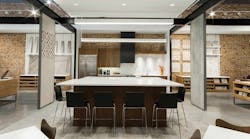In recent years, there has been a growing trend of building kitchens into showrooms. It may seem innocuous, particularly since kitchens are commonplace in residential settings and places for food storage that resemble kitchens have been commonplace in office environments.
However, the introduction of fully functioning kitchen spaces, complete with ovens, food and beverage storage, a stocked coffee or drink bar, and, at times, stovetops designed to be open to the rest of the showroom, is a new occurrence. Even offices, which have long-since introduced refrigerators and coffee machines into the workspace, would shy away from offering employees the utilities to do more than zap their meals in the microwave. Kitchen areas have often been designed to be hidden away from view—out of sight, out of mind; these areas are for the quick completion of the task at hand so one may return to work.
Within the trending open- and no-office workspaces, we see the “heart of the home” settling into showrooms of all sorts, which seems unusual. Showrooms are spaces for design solutions where brands display their new releases and tried-and-true favorites. It seems almost against the nature of the space to use precious square footage to build in fully functional kitchens that may only be used a few times a year, particularly in an era when space is an expensive commodity. Yet, we see it repeatedly. For Lindsay Wilson, executive managing principal at Corgan, who designed the new Mannington showroom in Atlanta, the inclusion of a kitchen area was a means of answering the design question, “How hard can we get the space to work?”
Having a working kitchen appears to be a no-brainer; after all, these areas typically serve as extensions of offices, and employees need a place where they can store and prepare their meals throughout the day. However, as the solution has generally been to provide a refrigerator and microwave—both of which can be essentially hidden in an office setting—and to have food at catered events, having a complete, operational kitchen goes beyond what is necessary. The answer lies in the historical repositioning of kitchens in American homes as centers of industrial manufacturing, and the emphasis of cooking as a participatory art as positioned by cooking and home design television shows.
The merging of domestic kitchens and work environments has historical ties. Kitchens, while relegated as domestic task centers, have been what Deyan Sudjic, director of the Design Museum in London, describes in his book “B is for Bauhaus, Y is for YouTube” as “a buffer zone between the help and family.” In the Western world, food preparation was either a family activity done in full view of the living space, or, for the wealthier socialites, taken on by hired help or servants. Kitchens were out-of-sight from visitors, where the general housekeeping could be done between the homeowners and their staff. It was not below the status of the woman of the house to approach servants there, unlike in the servants’ quarters. After free work was abolished along with slavery in the 19th century, the work of food preparation fell on the woman of the house, particularly in the 20th century as the middle class continued to grow. The positioning of the home as a place of serious work that could utilize manufacturing and technological ingenuity also turned “women’s work” into a science. Home economics was a way for women to safely explore these scientific fields.
Outside the home, the Industrial Revolution and advancements in science—particularly germ theory—made the general population more aware of ways in which the manufacturing process could be streamlined and how illness could be prevented, particularly in food preparation. While still a luxury, technology for the kitchen in the form of coolers and electric or gas stoves was more widely available to middle-class homes.
The kitchen as a more advanced working space was expanded upon by Lillian Moller Gilbreth in the inter-war period. An industrial psychologist and engineer, as well as the mother of twelve children, Gilbreth had worked side-by-side with her husband Frank B. Gilbreth to lessen the workload experienced by those on the factory line. In what would become known as “motion study,” the Gilbreths broke down work tasks into what they called “therbligs” to streamline the process, making the job faster and less taxing on the individual. After Frank’s sudden death in 1924, Lillian found she was able to continue her efforts through the “woman’s work” of tasks around the home. As Alexandra Lange quoted in “Belles on Their Toes,” written by two of the Gilbreth children: “If the only way to enter a man’s field was through the kitchen door, that’s the way she’d enter.”
PageBreak
Gilbreth’s studies turned the act of cooking and cleaning into a scientific formula. By the 1920s, the primary laborer in the home was the woman of the house, with an estimated 50 percent of her time spent in the kitchen. Gilbreth rearranged the layout of the kitchen—up until this point set up so that chillers and ovens stood at the periphery of the room—so that the mixing of ingredients, baking, and cleaning could be completed with the least amount of steps. As the basis of their labor studies, the Gilbreths used steps as a metric for determining productivity, and in her kitchen studies, she used the same to determine the productivity of the individual. In 1931, “Better Homes Manual” described Gilbreth’s “Kitchen Practical”—a test kitchen designed in partnership with the Brooklyn Borough Gas Company in 1929—as having decreased the number of steps taken by the user from 281 to 45 during the making of a strawberry shortcake.
The advancements and availability of kitchen technology in the home continued to grow throughout the mid-century. After World War II, technologies which had previously been used by the military were commercialized for civilian use, as with the microwave, which was first introduced by Westinghouse during the 1933 World’s Fair in Chicago, although it wouldn’t become commonplace until after the war. The post-war period also introduced advancements in refrigerator and stove technology. As Gilbreth’s layout became standard in American homes, the kitchen became a boasting space for the United States’ ingenuity and manufacturing. This is evidenced by “The Kitchen Debate”—a series of exchanges between then-Vice President Richard Nixon and Soviet leader Nikita Khrushchev during the opening of the American National Exhibition in Sokolniki Park in Moscow on July 24, 1959. The exhibition served as a competition between the warring countries locked in the Cold War, using the kitchen as a representative of capitalism versus communism. In this regard, the kitchen had it all: technology, efficiency, domesticity, and an importance in every home regardless of social status.
The post-war period also saw the kitchen take on a managerial location. Newly designed tract housing, as seen in Levittowns, placed the kitchen sink below windows which would open to the front or backyards, where the woman of the house could easily watch over her children playing outside.
In recent years, spurred by cooking shows and the HGTV network, the interior plan of the home has reverted more commonly to place the kitchen in open view to the rest of the home, although less as a means of allowing the meal-preparer to keep a watchful eye on others, and more due to cooking acting as entertainment. Guests can sit in view of the host’s food preparation, acting as the professional chef.
This open-kitchen design has moved from Gilbreth’s enclosed C-shape to an open U-shape, which is often the darling of HGTV redesign shows. It also easily blends into the layout of open offices and showrooms, often with a counter that also acts as an additional work surface or, in the example of Shaw’s Atlanta showroom, the reception desk.
The kitchen’s role as the heart of the home takes on an additional meaning in showrooms by creating a place where people can make themselves comfortable. While we often discuss the merits of an open office versus a closed, little has been stated about no-office arrangements. With recent studies showing 35 percent of the U.S. workforce now working as freelancers, with many more able to do their work from anywhere, workers are untethered from not only the desk, but from the workplace in general. Wilson recently stated that Mannington’s new showroom was designed as a space where clients and designers can set up their laptops or tablets to get work done. “One of the main goals for [Mannington was] to serve a lot of purposes… they wanted it to be a comfortable place for the Atlanta design community.”
What does this all mean for interior designers? Mainly, it is important to note that as work-life balance is discussed, kitchens need to be part of that conversation. While gyms and spaces for relaxation are becoming incorporated into the offices of more wellness-focused employers, no room in the home has been as welcomed into the workforce as kitchens.
The open addition of kitchens in showrooms has implications for the wider retail and hospitality markets, as well. As brick-and-mortar stores look for new ways to attract consumers, we may see retail taking a note from the design industry. The introduction of Keurig’s individualized service in shops, for example, signals to shoppers that they can relax while they are in the store. With that, specialty coffee services are being integrated into hospitality, as seen at the ACME Hotel in Chicago, which has removed the standard coffee maker from guest rooms and instead offers premium coffee delivery. This lends to a culture of individualized, on-demand food and beverages.
This expectation of personalization has already permeated the workforce. As Wilson pointed out, campuses such as Google and Facebook have adapted to “the culture of customization.” Weekly or even daily changes to their menus, complete with preparation lines in full-view and seemingly limitless customization, only adds to society’s expectation that what someone is craving on any given day can be readily available.
It isn’t a narrow trend that showrooms are incorporating open kitchens; we are continuing to see the integration of cooking and food-and-beverage storage spaces in offices and design centers. Carl Hansen & Son’s New York showroom provides food and drink along the installed kitchen island, while Interceramic uses an open kitchen to create an inviting setting for the design community to come in and make use of the showroom. At Carvart’s new NYC space, a 40-foot steel island was inspired by CEO Edward Geyman’s love of food and hospitality, and is used for cooking presentations. Also in New York, Kimball Office’s new showroom features a kitchenette where visitors can prepare beverages of choice, and Poppin’s office kitchen is fully stocked with healthy food and drink options for both its guests and its predominantly millennial staff.



